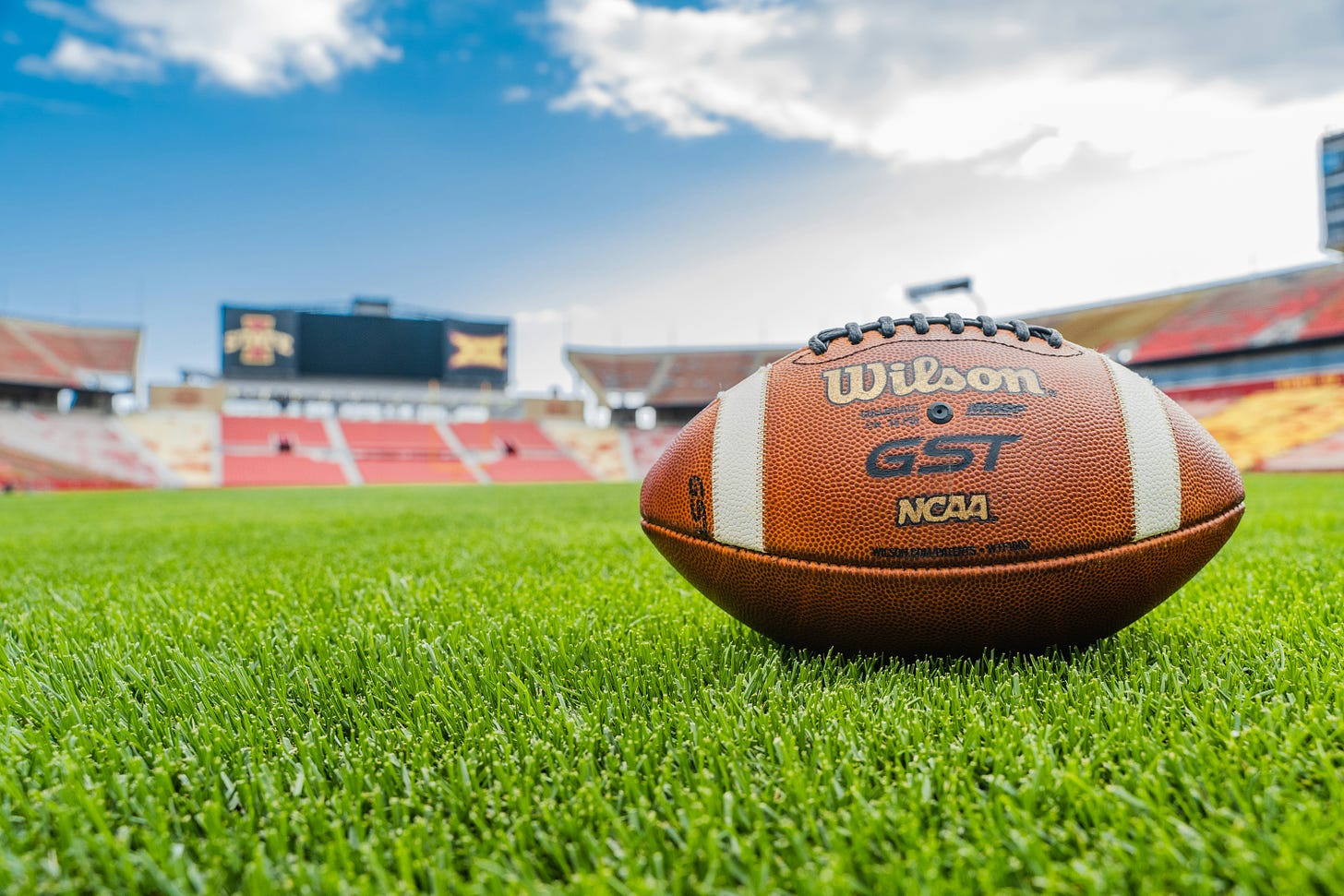Budgetary battles: Private equity in college sports
How private equity creeping into college athletics affects the sport's future

Let me start with something clear and simple that should dispel a lot of thoughts around this new concept: private equity isn’t that scary.
Now, if you’ve been doomscrolling through your favorite college football sites and message boards, you’ve probably seen differently. After all, private equity means the Saudis are getting in bed with the SEC, right? Wrong.
But now I’m getting ahead of myself. Why are we even talking about private equity in college football? You can turn your attention to always inventive Brett Yormark and the Big 12, who are considering selling the naming rights to the conference. As soon as the report surfaced about Yormark and the Big 12, multiple Group of Five conferences, including the American, Conference USA, and Mountain West, also came out stating they were considering selling naming rights.
What even is private equity?
It’s probably best to start here, right?
Private equity, or PE, are funds of pooled investments used to invest large sums of money, according to ProPublica. Most PE is managed by specific PE firms that, like many investment funds, focus on maximizing profits.
Most times, PE funds are made up of real movers and shakers. These aren’t funds for people like you or me. We see large institutional investors like pension funds, sovereign wealth funds, endowments and exorbitantly wealthy investors pay into these funds.
Recently, there’s been a ton of news about the expanding scope of private equity firms. They’ve moved into health care, the housing market, even fishing. Now, their attention seems to be focused on sports, with college sports becoming the latest potential marketplace for these massive investors.
According to WealthManagement, PE-backed firms and affiliated shops have stakes in 63 major North American professional sports teams. Investments total $243.8 billion.
Why are people worried about PE entering college athletics?
In all honesty, there’s been a lot of change in college athletics the past few years. Heck, even in the year since SID Sports has started. College athletes are able to make money off of NIL. Conferences have been redrawn like some poorly gerrymandered nightmare. Schools are being sued for labor violations and losing. A lot has changed and fans only have so much capacity for change.
But PE isn’t all its cracked up to be outside of the sports sphere, which raises concerns for the state of college athletics. Just take a look at the housing crisis currently going on across America. An October 2022 study by John Burns Real Estate Consulting show that PE firms purchased 25 percent of the houses flipped in the third quarter of that year. Along with the increase in PE firms purchasing homes, first time home buyers have been locked out of the housing market, with their shares falling from 43 percent of purchases in 2022’s first quarter to 32 percent in the third.
This newsletter isn’t about broader politics past sports, so I’m not going to dive deeper into the housing crisis or anything else. But, with numbers like that, it’s easy to see this as a bad step for college football, especially coupled with the looming demise of amateurism.
Putting politics aside, most of the changes in college football the past few years have been driven by one thing: money. Conference realignment? All about chasing those dollars. The SEC, who poached Oklahoma and Texas from the Big 12 and set off this chain of realignment, distributed $51 million in 2023 to each school through its media rights deal, per Sportico. The Big 12’s new deal, by comparison, nets each school $31.7 million annually. And that’s a raise from where it was before. The same can be said of the moves from the PAC-12, which was floundering and pushing teams to greener pastures financially.
The NIL changes, while for the better, also are driven by money. College student-athletes deserve to get paid for their labor and the value they generate for schools and stakeholders. They’re the ones putting their bodies on the line and they deserved to be compensated for that. Whether that compensation should come from NIL deals, endorsements, donors, or direct from school as employees is a different story. But this is a change determined by money.
When we start introducing a new stream of money, fans are right to be concerned about what comes next. What is my team selling out for this time? How is this going to negatively affect the game I love like so many of these other changes? For some fans, realignment ruins the sport by taking away regional battles or leaving their team out dry. For others, NIL deals and the House settlement put sports they love on the chopping block. Being worried about private equity entering into college sports is fine. I’d even say it’s a fair belief. But it’s not as bad as you think.
Maybe this isn’t too bad
The main thing a lot of people are missing in this is that private equity is already here. Remember that Business Insider study we talked about earlier? Let’s dig a little deeper there.
In the NBA, 20 of the 30 franchises have private equity connections, raking in an estimated $74.2 billion each year. The MLB lags a bit behind that with 18 of the 30 teams taking in PE money to the tune of $47.7 billion each year. Even the MLS is in on the party with 15 of 29 clubs boasting private equity connections totaling $10.6 billion. Finally, the NHL is newest to the party with 10 of its 32 franchises bringing in PE investors for $15.2 billion each year. The NFL doesn’t allow private equity in their ownership groups, which is why they’re the only of the Big Four American leagues not mentioned.
For all of those teams and all of those dollars, you sure don’t hear about any corporate takeovers, do you? That’s not to say it’s an impossibility, but it’s not something I see coming. Sports franchises are independently owned and ran organizations that are for-profit. University athletic departments are fundamentally different.
For a professional franchise, private equity can be used to purchase a stake in the business. Athletic departments, however, are subsidiaries of their home institutions. There are no ownership stakes to be sold. What makes a private equity firm like Blackrock different than your school’s biggest donor? Absolutely nothing!
Colleges sell naming rights to things all the time. For every Ohio Stadium there is a Kroger Field. You probably don’t know this, but a lot of head coaching positions are sold off to donors. Take USC’s Lincoln Riley for example. He’s not the Head Football Coach, his official title according to the USC Trojans website is C. & J. Elerding Head Football Coach. I don’t know how much the Elerdings paid for the naming rights to Lincoln Riley, but does that really impact your enjoyment of college sports? What about the Michigan State Spartans presented by Rocket Mortgage? While that was a much maligned and memed move, do you still think about it at all? Sure, the team never really changed their name, but the sponsorship is still there.
What differentiates these naming rights and presenting sponsorships from private equity? I’d say absolutely nothing!
Remember our definition of private equity from the start of this article: “funds of pooled investments used to invest large sums of money.” We’ve seen a lot of one donor investing large sums of money. What difference does it make if investments are pooled?
Also, do you know what else is run by pooled investments, or more accurately, donations? NIL Collectives!
Private equity is a scary term with a strong connotation to it that revolves around political and socioeconomic issues like the housing crisis and rising healthcare costs. But it’s already been in bed with college athletics for a long time. The past two Rose Bowls have actually been called The Rose Bowl Game Presented by Prudential. How many of you noticed that? And how many are clamoring for Tostitos to reclaim its rightful sponsorship over the Fiesta Bowl? That’s all private equity. It’s already here, and it’s not that bad.
Further Reading:
So what’s next?
Now that we’ve established the idea that private equity is already in college athletics and decidedly not bad, let’s turn our attention to the future. What’s next?
Based on reports by Yahoo! Sports’s Ross Dellenger, conference naming rights are next on the docket. Right now, we know the sponsors targeted by two conferences: the Big 12 is aiming at Allstate and Conference USA is taking shots for Globe Life.
When corporate sponsors, or private equity as everyone calls them now, are looking to sponsor something, there’s one big thing driving prices: brand equity and loyalty.
According to Investopedia, brand equity is “the value premium that a company generates from a product with a recognizable name, when compared to a generic equivalent.” Brand exposure and loyalty - how likely consumers are to choose a brand - are major determining factors on investments and if sponsors or private equity want to invest in it.
Want a real-life demonstration of brand equity? Take a look at Elon Musk’s management of Twitter/X. Twitter amassed exorbitant amounts of brand equity and value. Twitter and tweets became a massive part of our lexicon. Merriam-Webster even added a second definition to Tweet as “a post made on [Twitter].” Then, Musk changed the name of the social media outlet to X and renamed tweets to posts. That move alone, according to Bloomberg, erased anywhere between $4 and $20 billion in brand value. Simply because the name change destroyed all that hard earned brand equity.
All that is to say, conferences carry massive amounts of brand equity. Corporate sponsors aren’t looking to destroy that in the name of extra exposure for their brand. Ever wonder why the Big 10 and Big 12 haven’t changed their numbers to actually reflect the amount of teams in the league? That’s right, the entire brand is centered around that number. So if the Big 12 won’t become the Big 16 to account for its new schools, in what world is the “Allstate 12” going to not present those same problems?
Private equity is already here. It’s everywhere. I don’t fault conferences for looking for alternative revenue streams, though. We’ve already talked about the revenue gaps between the Big 12 and the SEC. Who’s to fault the Big 12 and Yormark for opening up a new revenue stream?
Especially with almost $22 million in damages set to be paid out by schools to athletes in the House v. NCAA settlement, schools need more revenue streams to offset their increasing costs. Some schools were flirting with and did cut programs in the wake of COVID-19. What’s to stop them from doing the same when an extra $22 million leaves the books going forward?
Private equity is going to continue to grow in college athletics. Schools and conferences are going to continue to look for more things to increase their revenue streams. By approving the House settlement, that’s all but guaranteed. But if private revenue just means more naming deals and presenting sponsors, which it most likely will, this all is a big nothing-burger. Remember one thing in conversations about private equity and college athletics: they want to maintain brand equity. Not much can change that would keep that brand equity up.
Have any questions, ideas, article pitches, or information? With the new Substack features, you can directly message me! Hit the button below to send me a message, or reach out via email to sidsports23@gmail.com, or find us on your favorite social media platform like Facebook, Instagram, Twitter, Substack Notes and Bluesky.








Found you on Reddit.
Thanks for breaking this down! I fall into the category of I’m okay with most of the changes but how the eff can I keep up with it all lol. This one was particularly confusing but you broke it down nicely. Also, it’s unbelievable that the NFL doesn’t have PE! In a million years I would have never guessed that